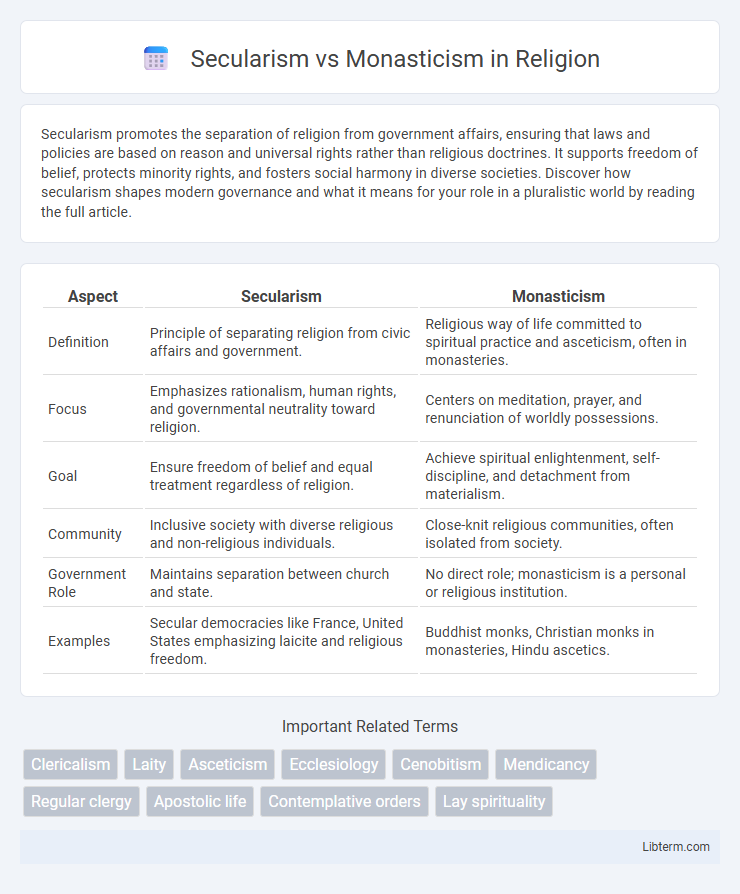Secularism promotes the separation of religion from government affairs, ensuring that laws and policies are based on reason and universal rights rather than religious doctrines. It supports freedom of belief, protects minority rights, and fosters social harmony in diverse societies. Discover how secularism shapes modern governance and what it means for your role in a pluralistic world by reading the full article.
Table of Comparison
| Aspect | Secularism | Monasticism |
|---|---|---|
| Definition | Principle of separating religion from civic affairs and government. | Religious way of life committed to spiritual practice and asceticism, often in monasteries. |
| Focus | Emphasizes rationalism, human rights, and governmental neutrality toward religion. | Centers on meditation, prayer, and renunciation of worldly possessions. |
| Goal | Ensure freedom of belief and equal treatment regardless of religion. | Achieve spiritual enlightenment, self-discipline, and detachment from materialism. |
| Community | Inclusive society with diverse religious and non-religious individuals. | Close-knit religious communities, often isolated from society. |
| Government Role | Maintains separation between church and state. | No direct role; monasticism is a personal or religious institution. |
| Examples | Secular democracies like France, United States emphasizing laicite and religious freedom. | Buddhist monks, Christian monks in monasteries, Hindu ascetics. |
Understanding Secularism: Definition and Origins
Secularism is a principle advocating for the separation of religious institutions from governmental and public affairs, ensuring that religious beliefs do not dictate laws or policies. Originating during the Enlightenment era in 17th and 18th century Europe, secularism emerged as a response to religious conflicts and the desire for rational governance based on reason and empirical evidence. This concept promotes neutrality in public spheres, allowing diverse beliefs to coexist without state endorsement of any particular religion.
Monasticism Explained: History and Core Principles
Monasticism originated in early Christianity as a movement where individuals renounced worldly life to pursue spiritual growth through ascetic practices and communal living. Core principles include vows of poverty, chastity, and obedience, emphasizing simplicity, prayer, and self-discipline. Historically, monastic communities like Benedictine and Cistercian orders played crucial roles in preserving knowledge, education, and cultural development throughout medieval Europe.
Key Differences Between Secular and Monastic Lifestyles
Secular lifestyles emphasize active engagement in everyday society, involving careers, family responsibilities, and civic duties, while monastic lifestyles center on religious devotion, communal living, and celibacy within monasteries. Secular individuals balance worldly concerns and spiritual practices privately, whereas monastics adopt formal vows, structured routines, and separation from secular affairs. The key distinction lies in monasticism's communal commitment to spiritual discipline versus secularism's integration of spirituality with public and personal life.
Philosophical Foundations: Worldviews in Conflict
Secularism emphasizes a human-centered worldview prioritizing reason, empirical evidence, and individual autonomy, often rejecting supernatural or religious explanations. Monasticism, rooted in spiritual discipline and transcendence, advocates for a life dedicated to divine connection, renunciation of worldly desires, and contemplative practices. This philosophical conflict highlights contrasting approaches to existence: pragmatic materialism versus spiritual idealism.
Role of Religion in Secular vs Monastic Societies
Secular societies prioritize the separation of religion from state affairs, emphasizing individual freedom and pluralism while minimizing religious influence on laws and governance. In contrast, monastic societies center around religious institutions, where spiritual practices and religious authority guide social norms, education, and community life. The role of religion in secular contexts is largely symbolic or personal, whereas in monastic settings, it is fundamental and institutionalized.
Education and Knowledge: Secular vs Monastic Approaches
Secular education emphasizes broad, inclusive curricula promoting critical thinking, scientific inquiry, and diverse worldviews, fostering skills for modern societal engagement. Monastic education prioritizes religious doctrine, spiritual discipline, and preservation of sacred texts, nurturing moral development and contemplative knowledge within a specific faith tradition. The secular approach encourages open inquiry and adaptation, while monastic education maintains structured, tradition-centered learning focused on spiritual wisdom.
Daily Life and Rituals: Contrasting Experiences
Secularism in daily life emphasizes individual autonomy, rational decision-making, and engagement with worldly affairs, with routines centered around personal and professional responsibilities rather than religious observance. Monasticism, by contrast, involves a disciplined daily schedule structured around communal prayers, meditation, and ritualistic practices designed to deepen spiritual devotion and detachment from material concerns. The experiential divide manifests in secular lifestyles prioritizing secular ethics and multitasking, while monastic routines cultivate contemplative silence, simplicity, and repeated sacred rites.
Social Impact: Contributions to Community and Culture
Secularism promotes social inclusivity by encouraging diverse cultural expressions and civic engagement beyond religious frameworks, fostering pluralistic societies and advancing human rights. Monasticism contributes to community cohesion through contemplative traditions, charitable activities, and the preservation of religious art, literature, and education. Together, these paradigms shape cultural heritage and social dynamics by balancing individual freedom with collective spiritual and ethical values.
Modern Debates: Secularism and Monasticism Today
Modern debates on secularism versus monasticism focus on the balance between individual spiritual freedom and institutional religious authority in contemporary society. Secularism promotes the separation of religion from state affairs, emphasizing pluralism and personal choice, while monasticism upholds traditional religious disciplines and communal spiritual practices. Current discussions explore how both frameworks adapt to global cultural shifts, technological advancements, and evolving ethical values.
Bridging the Divide: Can Secular and Monastic Values Coexist?
Secularism and monasticism represent distinct value systems, with secularism emphasizing worldly engagement and individual freedom, while monasticism focuses on spiritual discipline and communal detachment from material concerns. Bridging the divide involves recognizing shared principles such as ethical living, self-discipline, and a commitment to personal growth, which can harmonize secular and monastic ideals. Integrating monastic values of mindfulness and simplicity into secular contexts promotes holistic well-being, enabling coexistence that respects diversity in spiritual and material pursuits.
Secularism Infographic

 libterm.com
libterm.com